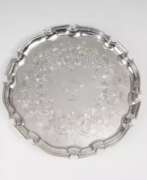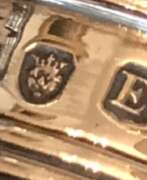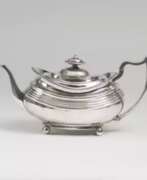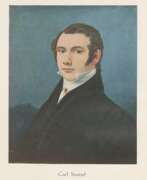Jewelers 18th century


Francois Dormieux was a French engraver and jeweler who lived and worked in Calcutta, India, in the late 18th and first half of the 19th centuries.
Francois Dormieux's own published book Hindoostany Characters (Hindoostany Characters, 1805), now in the British Library, is well known. It consists of forty very high quality engravings made from artists' drawings. They depict the people of India in their daily lives, their culture and traditions.
As a jeweler, Francois Dormieux worked in partnership with Francis Vrignon in a company called Francis Dormieux & Co. that made jewelry and beautiful silverware in the colonial style.


Abraham Drentwett II the Elder was a German painter, goldsmith and engraver.
This master was one of the great Augsburg dynasty of Drentwett artists, numerous members of which worked primarily as gold and silver jewelers for the ruling courts of Europe from the 16th to 18th centuries.


Jean-Claude Chambellan Duplessis was a goldsmith, sculptor and ceramics modeller, bronze-founder and decorative designer working in the Rococo manner. He served as artistic director of the Vincennes porcelain manufactory and its successor at Sèvres from 1748 to his death in 1774 and as royal goldsmith (orfèvre du Roi) from 1758 to 1774.


Robert Hennell was an English silversmith and engraver, best known for his work during the Georgian era. He was apprenticed to the silversmith John Scofield before setting up his own workshop in 1763.
Hennell's silver pieces were highly sought after for their quality and craftsmanship. He produced a wide range of objects, from tea services to candlesticks, and his designs were characterized by their elegant simplicity and attention to detail. He also created a number of commemorative objects, including the silver casket presented to Lord Nelson by the City of London in 1800.
In addition to his work as a silversmith, Hennell was also an accomplished engraver, and his work can be found on a number of coins and medals from the Georgian era. He was a member of the Royal Academy and exhibited his work at the Royal Academy exhibitions throughout his career.
Today, Hennell's silver pieces and engravings can be found in the collections of museums around the world, including the Victoria and Albert Museum in London and the Metropolitan Museum of Art in New York. His work continues to be admired for its beauty, quality, and historical significance.


Gerhard Ludvig Lahde was a Danish painter, engraver and publisher.
Lahde studied at the Royal Danish Academy of Fine Arts, worked as a jeweler and portrait painter, creating many portraits of prominent people of his time. But Lahde was mainly concerned with depicting Danish civil and military costumes, street vendors and small merchants. In collaboration with the artist Johannes Zenn, he created a series of hand-colored, somewhat caricatured reproductions of traditional costumes, and also worked on depictions of major historical events, such as the Copenhagen fire of 1795 and the British bombardment of Copenhagen in 1801 and 1807.


Charles Le Bastier, son of a Paris mercer of the same name, was apprenticed on 3 October 1738 at the age of 14, to Gabriel Vougny, marchand-orfèvre-joaillier. With the sponsorship of Jean Moynat, himself a noted gold box maker, Le Bastier became master goldsmith on 20 December 1754. He worked from the same premises in the rue Thévenot, near the rue St-Denis, until last recorded in 1783. Le Bastier was a successful and prolific maker of gold boxes who also supplied other retailers such as Jean-François Garand and Grancher of Du Petit Dunkerque, whose name or shop name appear engraved on the rims of several of Le Bastier's boxes. In the special tax list of 1774, he was listed 9th in order of the importance of his business. Since a number of Le Bastier's boxes survive in various collections (most notably in the Louvre and the Thurn und Taxis Museum, Regensburg), it is possible to trace the progression of his work from the earliest silver boxes with coloured gold ornament through a series of richly chased but comparatively plain gold boxes to the almost immediately recognisable gold and enamel boxes of his maturity.


Pierre Platel was a Huguenot silversmith, born c. 1664 in Lille and arriving in England in 1688. He was endowed in 1697, and in 1699 was granted his freedom by ransom, after which he was recorded as a major labourer. Paul de Lamery was taken on as his apprentice in 1703 and remained there until 1713. The paymaster died in 1719. His most significant works belong to the Bentinck or Cavendish families.


Paul Revere was an American silversmith, engraver, early industrialist, Sons of Liberty member, and Patriot and Founding Father. He is best known for his midnight ride to alert the colonial militia in April 1775 to the approach of British forces before the battles of Lexington and Concord, as dramatized in Henry Wadsworth Longfellow's 1861 poem, "Paul Revere's Ride".


Philip Rundell was a highly prosperous English jeweller, fine jewellery retailer and master jewellery makers' business proprietor, known for his association with royalty. With John Bridge, he ran and co-owned Rundell and Bridge, a firm with widespread interests in the jewellery and precious metal trades.


Paul Storr was an English goldsmith and silversmith working in the Neoclassical and other styles during the late 18th and early 19th centuries. His works range from simple tableware to magnificent sculptural pieces made for royalty.


Georg Friedrich Strass was an Alsatian jeweler renowned for his invention of imitation gemstones, particularly the rhinestone, which is called "strass" in many European languages. Born on May 29, 1701, near Strasbourg, Strass made significant contributions to the field of jewelry by discovering a specific type of crystal in the Rhine River that he used to craft these imitation gems. His innovative techniques included using bismuth and thallium mixtures to enhance the refractive qualities and altering colors with metal salts. Strass's simulated gemstones were so convincing that he established the concept of "simulated gemstone" to categorize them.
By 1730, Georg Friedrich Strass had launched his own business, focusing on creating artificial diamonds, and his exceptional work led to him being honored as the "King's Jeweler" in 1734. His creations were highly sought after, especially at the court of King Louis XV of France, where he maintained a significant market presence for his artificial gems. His success in the industry allowed him to retire comfortably at the age of 52.
For collectors and art and antiques experts, Georg Friedrich Strass's legacy is a testament to the ingenuity and craftsmanship of the 18th century, offering a fascinating glimpse into the history of jewelry making. His work remains influential, illustrating the blend of art, culture, and history in the realm of jewelry design.
If you are interested in the intersection of art and innovation as exemplified by Georg Friedrich Strass's work, consider signing up for updates on new product sales and auction events related to his inventions. This subscription will provide you with insights into the ongoing relevance and appreciation of Strass's contributions to jewelry and art.
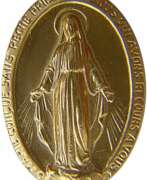

Adrien Vachette was a French jeweler of the 18th and 19th centuries, best known as the creator of the so-called Wonderful Medallion.
Vachette was one of the most famous and prolific craftsmen of his generation. He was appointed court jeweler and supplier to the court of King Louis XVIII. Gold, tortoise shell, enamel, precious stones and ornamental stones were used extensively in the creations of Vachette, particularly in the many precious snuffboxes that were in fashion at the time.
However, he became famous at a very advanced age, when he was almost 80 years old. Paris at the time was experiencing a cholera epidemic and a period of political instability. The Archbishop of Paris, Iasent-Louis de Quelan, had the idea of solving these problems by a miracle. At his behest, Vachette designed a "miraculous medallion" depicting Our Lady. Between 1832 and 1836, more than two million copies were distributed. At the same time, Archbishop Kaelan and his clergy were active in the fight against cholera. All in all, this contributed to the growth of religiosity and respect for the church in France, and the marvelous medallions of Vachette's design continue to be minted and distributed in many Western countries to this day.
